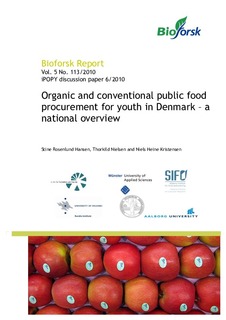| dc.description.abstract | This report is a mapping of the activities within public procurement of organic food for youth in Denmark, with a special focus on school meals. In Denmark, it is voluntary whether local municipalities or schools arrange school meals or not. Until lately this was also the situation for meals in daycare institutions, but in 2008 a new legislation made it mandatory for the municipalities to offer a lunch meal in all daycare institutions, though this is still mainly financed by user charge. This change in legislation received much public attention, and has been heavily debated.
School meals in Denmark were first introduced around 1900 as a social project for children in poverty, and have since been undergoing many changes. In the 1930‟s the warm meal was replaced by a cold lunch. During the 1970‟s free meals for malnourished children was gradually replaced by food stalls, selling milk, bread and fruit. Until the beginning of the 2000‟s such food stalls were widely spread, and in the 1980‟s and 1990‟s it was very common that pupils were responsible for running the stalls, receiving the profit for class excursions etc. In recent years a public and political debate about school meals has again aroused, mainly arguing that the food stalls is often offering a very unhealthy selection of food, and also pointing to the fact that many pupils bring unhealthy lunch from home or from nearby shops. Hence the argument that the public should help to ensure a healthy lunch for the pupils is again beginning to manifest, though there is no consensus on how this should be done and to what extent this should be funded by the public.
Over time, more and more schools or municipalities choose to establish school meal systems, but these vary extensively in the way they are organized, what kind of food is served, and how they are financed. This report includes an overall mapping of the different ways of organizing school meals and their dissemination.
Organic food has also been increasingly debated in relation to public procurement for children and youth, mainly in relation to meals in daycare institutions. Organic food is used in some school meal systems especially in municipalities inspired by Agenda 21, such as the municipalities in the Green Cities cooperation, but also other municipalities such as Esbjerg, Gladsaxe and Roskilde emphasize organic food. Whether the subject of organic food is discussed and implemented depends on the local values, goals, resources and politics. Hence there are municipalities and institutions with no organic food at all, while others have an organic share of more than 90 %. This is particularly in the municipalities situated in the Greater Copenhagen area. The municipalities in the Green cities cooperation have an average share of 59 % organic in all public procurement. The number is even higher when looking exclusively at public procurement for children and youth. These cases are briefly described in the report, along with a short mapping of other municipalities using organic food in meals for daycare institutions or schools.
The report was produced in the iPOPY project, “innovative Public Organic food Procurement for Youth”. Similar reports have been produced for the other iPOPY countries; Norway, Finland and Italy. | nb_NO |
